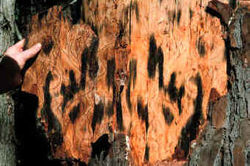
The Saccharomycetaceae are a family of yeasts in the order Saccharomycetales that reproduce by budding. Species in the family have a cosmopolitan distribution, and are present in a wide variety of habitats, especially those with a plentiful supply of carbohydrate sources. The family contains the species Saccharomyces cerevisiae, perhaps the most economically important fungus.

Dothideomycetes is the largest and most diverse class of ascomycete fungi. It comprises 11 orders 90 families, 1,300 genera and over 19,000 known species. Wijayawardene et al. in 2020 added more orders to the class.

Valsaceae is a family of sac fungi in the Diaporthales order.

The Helotiaceae are a family of fungi in the order Helotiales. The distribution of species in the family are widespread, and typically found in tropical areas. There are 117 genera and 826 species in the family.

Peltigerales is an order of lichen-forming fungi belonging to the class Lecanoromycetes in the division Ascomycota. The taxonomy of the group has seen numerous changes; it was formerly often treated as a suborder of the order Lecanorales. It contains two suborders, eight families and about 45 genera such as Lobaria and Peltigera.
Schismatomma is a genus of lichenized fungi in the family Roccellaceae.
Sphaerulina is a genus of fungi in the family Mycosphaerellaceae.
Bimuria is a genus of fungi in the family Melanommataceae; according to the 2007 Outline of Ascomycota, the placement in this family is uncertain.
The Chaetosphaeriales are an order of fungi within the class Sordariomycetes.

The Ophiostomatales are an order of fungi in the class Sordariomycetes. They are commonly symbionts to insect species, which can be found in numerous cases, including some termites and many bark beetles. In the cases of most beetle symbioses, the Ophiostomatales fungi is carried in mycangia, which help keep fungal inoculants close to the beetle at all times. In some cases, the fungi are the main source of food for the beetles. In others, the relationship is not as clear.
Khuskia is a fungal genus in the class Sordariomycetes. The relationship of this taxon to other taxa within the class is unknown. A monotypic genus, it contains the single species Khuskia oryzae, described as new to science in 1963.

The Melanconidaceae are a family of fungi in the order Diaporthales, class Sordariomycetes.

Nephromopsis is a genus of lichenized fungi within the Parmeliaceae family.
The Microthyriaceae are a family of fungi with an uncertain taxonomic placement in the class Dothideomycetes.

The Rhytismatales are an order of the class Leotiomycetes within the phylum Ascomycota.

The Rhytismataceae are a family of fungi in the Rhytismatales order. It contains 55 genera and 728 species.

The Lasiosphaeriaceae are a family of fungi in the Ascomycota, class Sordariomycetes.
The Gymnoascaceae are a family of fungi in the Ascomycota, class Eurotiomycetes.
The Myriangiaceae are a family of fungi in the Ascomycota, class Dothideomycetes. Species in this family have a widespread distribution, and are typically found associated with scale insects. The family occupies an isolated phylogenetic position within the Dothideomycetes.

The Collematineae are an suborder of rust fungi in the order of Peltigerales in the class Lecanoromycetes.












